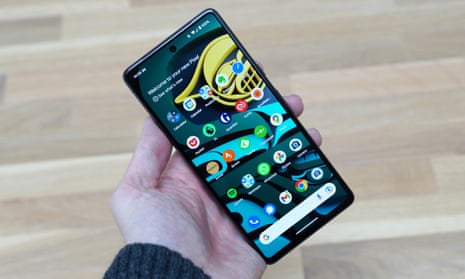The lack of bandwidth delayed the launch of Google smartphones in India, but after a long gap the company is picking up the pace, first with the Pixel 6a, and now with the recently launched Pixel 7 and Pixel 7 Pro to expand its smartphone portfolio here. Today, we are going to review the Google Pixel 7 and see how this flagship phone will stand against other flagship variants available within the same range. The Pixel 7 costs ₹59,999 in India.
We received the USB Type-A to Type-C adapter, Type-C to Type-C cable, documentation, and SIM ejector pin – but no charging adapter.The new Pixel 7 comes with a flat design and a unique aluminium strap on the back, consisting of the rear camera sensors. The new Pixel 7 is more compact when compared to its predecessor, Pixel 6. The phone feels very light in the hand and is easy to use.
The body of the phone is made of glass which is Gorilla Glass Victus. We had the lemon grass colour variant for review, which offers a striking look. The downside of the glass body is that it is very slippery and you need to have a firm grip to prevent the phone from falling. The placement of the power button on the right side is above the volume rockers which requires a lot of time to adapt to it because the power button is usually placed below the volume rockers. On the left side lies the SIM tray whereas the Type-C port and the speaker outlets are placed on the bottom. The phone comes with IP68 certification, making it water resistant up to 1.5 metres for 30 minutes.
The new Google Pixel 7 comes with a 6.3-inch OLED display which is smaller than its predecessor, which had a 6.4-inch display size. The display has a screen resolution of 1080×2400 pixels and an aspect ratio of 20:9. The display has 1,000 nits of normal brightness level and can push up to 1,400 nits. The presence of HDR10+ makes your viewing experience very delightful by producing sharp video details.
The colours reproduced are very bright and vivid. The viewing space has also been increased when compared to the Pixel 6 as the bezels are very thin. The display comes with a refresh rate of 90Hz. Being an Android phone, the Pixel 7 falls a little behind the likes of the OnePlus, Moto Edge 30 Ultra, and iQOO 9T on this aspect.
The new Pixel 7 arrives with the latest Android 13 and a clean user interface. The latest OS offers some advanced features like a free VPN which secures your data while browsing online, but that is not available to Indian users. Amongst all the advanced features, there is one we did not enjoy: the absence of the feature to clone apps, and especially WhatsApp. The feature to clone apps is something we like about Android phones and the strategy to remove it from Pixel is not comprehensible to us.
Speech and calling are two of the most intriguing features to be found on the Pixel 7. For instance, call screening enables Google’s voice assistant to answer the call and even inform you of its contents. During a class or meeting, you do not need to speak in order to answer a call. You can respond by typing as the AI transcribes what the person on the other end is saying. What you type will be read aloud to the caller by the voice assistant.
Google has used its own chipset, the Google Tensor G2, in the Google Pixel 7 to power the processor. The processor is very efficient in carrying out any task with ease and we did not come across any lag. The processor is faster and improved when compared to its predecessor. Yet, when comparing it with the phones that come with the Snapdragon 8+ Gen 1 processor, the new Pixel 7 falls a little short.
The graphics on the phone are handled by Mali-G710 MP7 which enhances your gaming experience by providing a seamless service. The games are restricted to a 90Hz refresh rate so if you play games with higher requirements, they will be adjusted to a 90Hz refresh rate. To support the processor to carry out the tasks, the company has added 8GB of RAM that does its job quite efficiently. For internal storage, the phone is supplied with 128GB of ROM.
The new Pixel 7 comes with a dual camera sensor where the first sensor is a 50MP wide lens with an aperture of f/1.9 and by default, it captures images in 12.5MP. The second lens is a 12MP ultra-wide lens with an aperture of f/2.2, 114 degrees FOV. The phone misses out on a dedicated telephoto lens which you get in the Pixel 7 Pro. The new Tensor chipset assists the cameras to deliver excellent images. In the daytime, the images which we captured with the main lens turned out to be very great with sharp details and with a little less rendering which you will like, as it keeps the essence of the original.
The main lens is quick to adjust to the environment and the subject differentiation in the portrait mode is on point. When we compared the photos of the Pixel 7 with the iPhone 14, we found out that the latter has an edge over the former. It would be more meaningful to say that the Pixel 7 competes with the iPhone 13. Although the phone lacks the telephoto lens due to the super res algorithm present on the new Pixel 7, the zoomed-in photos maintain the details precisely and keep them intact. The images captured at night were brilliant with sharp details, as we noticed the images maintained the colours, contrast, and noise in perfect balance. For better images at night, we would suggest using the night mode.
On the front, you get a 10.8 MP ultra-wide lens with an aperture of f/2.2. If you compare the selfies of the iPhone 14 and the Pixel 7, the difference in processing the images will be noticed – and our vote goes to the iPhone 14. Still, the selfies captured were excellent and were not processed too much so as to turn your skin unnaturally soft. The new Pixel 7 has increased overall camera quality and image processing capabilities when compared to its predecessor, thanks to improved ISP capabilities and machine learning algorithms.
The new Pixel 7 comes with a battery power of 4,355mAh, which is a little less than its predecessor that had 4,614mAh. Although the battery power has been reduced, the result in the longevity is no different. Rather, it has improved thanks to the new processor, which assists in slow discharge. The phone lasts a day easily on a single charge, with moderate use. The charging speed of the Pixel 7 disappoints us and it feels like it takes ages to get fully charged. Consider that there are phones in the market that can reach full charge within 30-40 minutes.


